Bioplastics: here is a name that sounds Nature! The reality is however more complex.
Bioplastics brings together two very different things: this name is used interchangeably for biosourced plastics or biodegradable plastics.
The term biosourced refers to plant-based plastics made from plant residues such as corn or beet, and made without the input of petroleum derivatives. Excluding the energy needed for their production, bioplastics do not consume fossil energy. Their raw material is renewable. Note that the first plastic that man invented was a bioplastic: the Hyatt brothers developed the celluloid in 1869, from wood cellulose and casein (milk protein) ...
The term biodegradable means that the material decomposes under the action of natural organic elements such as insects, bacteria, fungi and other microorganisms (see previous blog on plastics).
A bio-based (or biosourced) plastic is not necessarily biodegradable. Similarly, today we manufacture biodegradable plastic based on petroleum. Finally, some plastics are both bio-based and biodegradable. These two notions are fundamentally different.
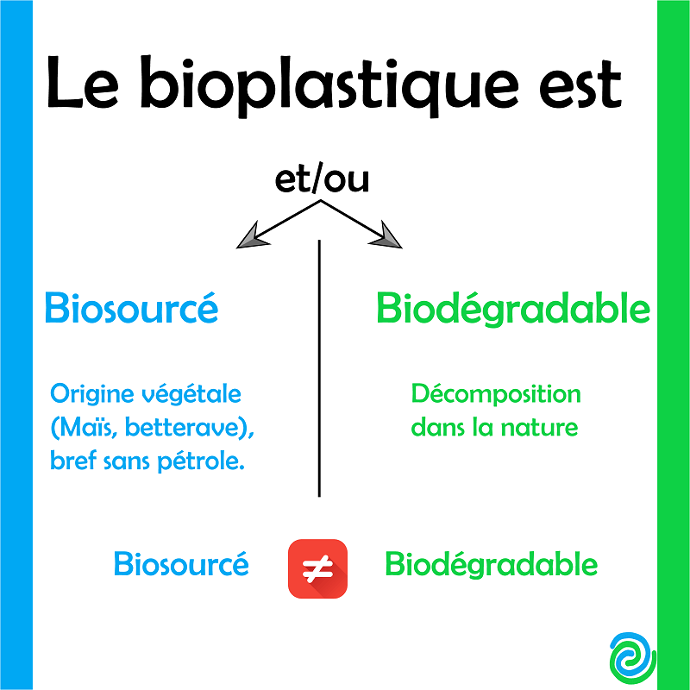
Should we favor biosourced plastic?
Bio-based plastic uses renewable resources as raw materials. The degradation of this plastic (for example by combustion) does not produce fossil CO2. However, it is still too early - the quantities produced are still relatively low - to say that the use of food resource derivatives to produce plastic will not have a negative impact on the prices of these food raw materials. We now know the impact that the introduction of biofuel in the automotive industry has had on the world scale on the price of the foodstuffs concerned (soybean, corn, ...).
Bio-based plastic has the same recyclability qualities as an identical petroleum-based plastic. Hence it poses the same problems of waste management as traditional plastic.
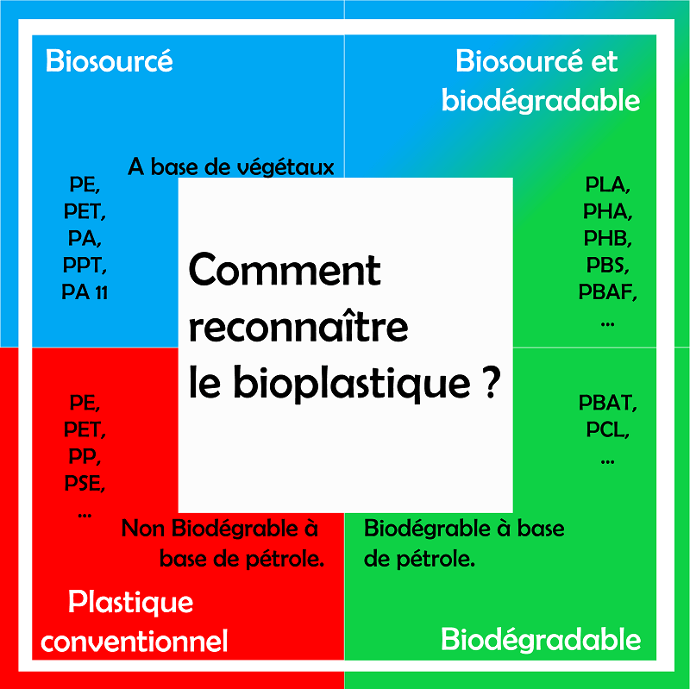
Is biodegradable plastic a solution to the pollution of the planet by plastic?
The term "biodegradable" ensures that a product (here plastic) can degrade naturally in the environment. But this does not indicate the rate of decomposition of a product, nor even the quality or toxicity of the residues. It is therefore currently difficult to assess the harmfulness of a "biodegradable" product for the environment. Be that as it may, the process of biodegradability of plastic in nature is always very long. It is illusory to rely on nature to remove our plastic waste, even if they are biodegradable.
Can compost be more effective?
Composting is biodegradation under specific temperature, humidity and oxygen conditions, and with human intervention to control the process. The "compostable" character of the products is also attested by certifications which this time verify the total decomposition within 6 months and the absence of toxic residues for the environment. A compostable product may not be biodegradable (if left in nature where the temperature is lower than in a compost), but its decomposition residues are not toxic. All in all, all that is not so simple all that ...
There are also two types of composts: industrial compost and home compost (which can be organized at home). Industrial composting provides relatively rapid decomposition in a high temperature environment (> 40 ° C). Most of the time, the decomposition gases are also recuperated and valorized, which guarantees greater energy efficiency.
There are certifications "OK compost" (indicating that the plastic can be put to industrial compost) and "OK compost HOME" (ensuring that the plastic can be composted at home).
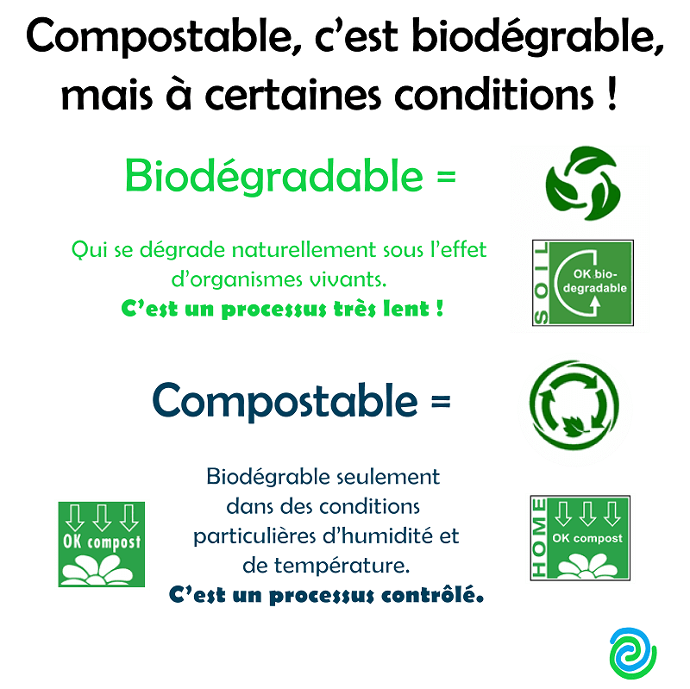
And recycling, is that always the solution?
Technically, all plastics are recyclable. Only all processes are not profitable at this time. That is, recycling is (much) more expensive than the production of new plastic. Tough luck for recycling channels ... There is still no recycling line for biodegradable plastic. It is classified in the "O" category as "other" (code 7) in recycling codes and is not currently recycled.
In addition, when the biodegradable plastic is mixed with traditional plastic (during a collective collection for example), it degrades the quality of the recyled product.
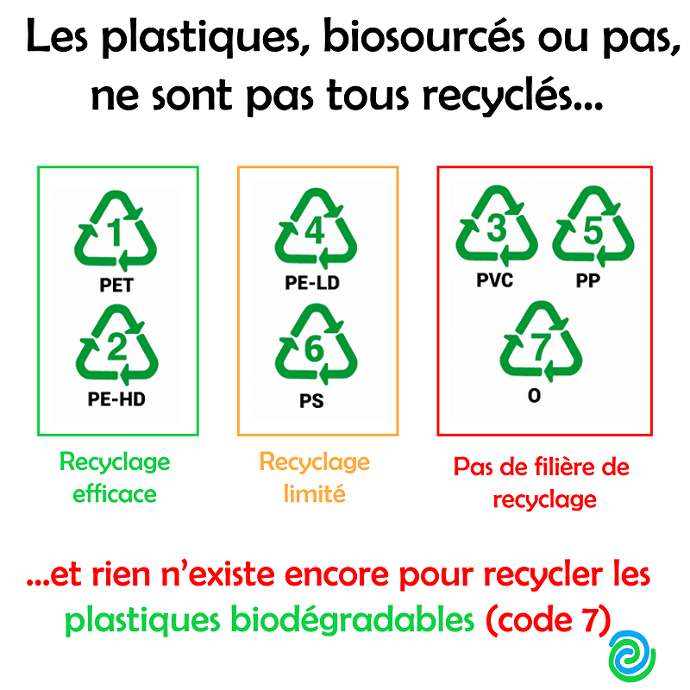
And the oxo-degradable plastic then?
Oxo-degradable plastic, also called oxo-biodegradable, is a plastic that breaks up under the combined action of light and oxygen. However, it does not break down. It is only broken up into smaller and smaller particles, which even become invisible to the naked eye. These particles stay long, very long in the environment. They are assimilated by microorganisms, and by all the animals that feed on them. Finally, it is in the human body that we find these microplastics. Toxic by nature, they have become a public health hazard in addition to a major problem for the environment. This product is so dangerous that it is gradually banned in all countries of the world.
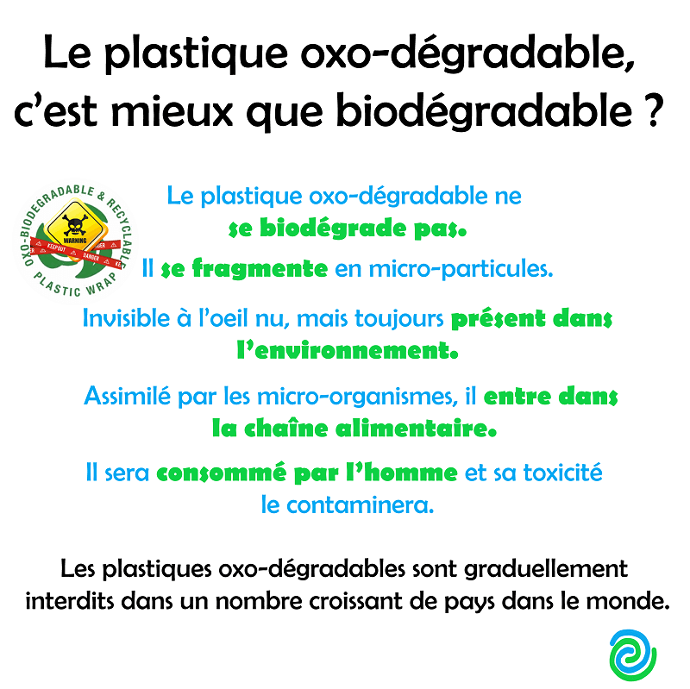
It is therefore difficult to navigate all this, and even more difficult to know what good attitude to adopt compared to bioplastics. To help you, here are some simple rules:
1. If you have a choice, refuse bioplastics just like traditional plastic, even biodegradable, even biobased. Certainly the disposable plastic (packaging, cup, straw, ...);
2. If the plastic is biodegradable, return it to an industrial composting center;
3. Only if it is compostable "HOME" (and industrial composting is not available), throw it into your home compost;
4. Do not give it to recycling ;
5. In any case, do not throw it in the wild
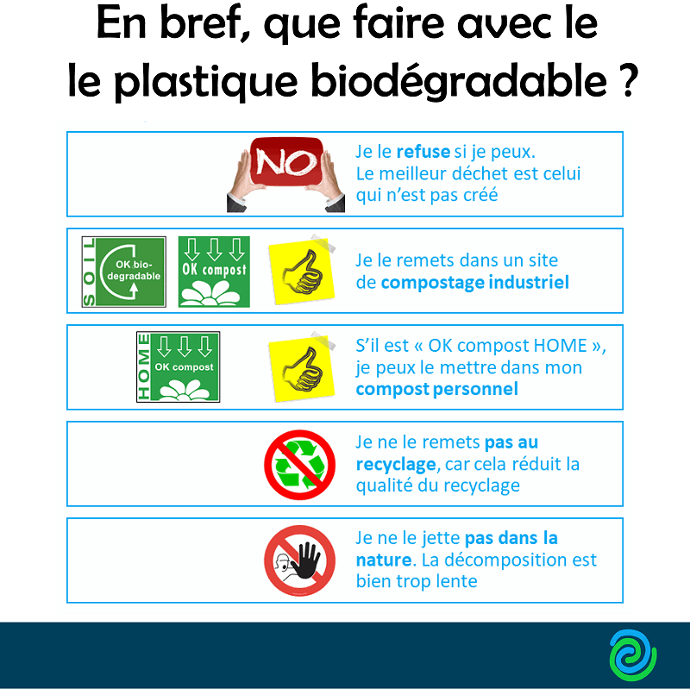
Useful sources and references:
Biodegradable polymers: a solution to plastic waste or just an important step towards circular economy?
Tom Collin
MChem Polymer essay, University of Surrey, May 2019
Interactive “beat the plasics” presentation
The United Nations Environment Programme (UN Environment) website
https://www.unenvironment.org/interactive/beat-plastic-pollution/
Many authored publications on plastics in oceans from UN, BBC, National Geographic and others
World oceans day organization website
https://www.worldoceansday.org/plastic-pollution-resources-1
7 Things You Didn’t Know About Plastic (and Recycling)
No identified author
National Geographic Blog, April 4, 2018
https://blog.nationalgeographic.org/2018/04/04/7-things-you-didnt-know-about-plastic-and-recycling/
Pourquoi et comment recycler le plastique ?
Pauline Petit
Consoglobe, 18 Mar 2019
https://www.consoglobe.com/recycler-plastiques-4312-cg/2
Biodegradability of Plastics: Challenges and Misconceptions
Stephan Kubowicz and Andy M. Booth
Environmental Science & Technology 2017 51 (21), 12058-12060
DOI: 10.1021/acs.est.7b04051
https://pubs.acs.org/doi/10.1021/acs.est.7b04051#
Top Eight Things to Know About Biodegradable Packaging
Axel Barrett
BioPlastics News, March 23, 2019
https://bioplasticsnews.com/2019/03/23/top-eight-things-to-know-about-biodegradable-packaging/
Le plastique biodégradable, la fausse solution contre la pollution
Pas d’auteur identifié
Metrotime,26/06/2018
https://fr.metrotime.be/2018/06/26/actualite/le-plastique-biodegradable-la-fausse-solution-contre-la-pollution/
A quoi correspondent les logos de vos emballages ?
Pas d’auteur identifié
Site Easy Recyclage (groupe Paprec)
https://www.easyrecyclage.com/blog/a-quoi-correspondent-les-logos-de-vos-emballages/
'Biodegradable' plastic bags survive three years in soil and sea
Sandra Laville
Site The Guardian, Mon 29 Apr 2019
https://www.theguardian.com/environment/2019/apr/29/biodegradable-plastic-bags-survive-three-years-in-soil-and-sea
Certification of Compostable / Biodegradable Products
Site TUV-Austria
http://www.tuv-at.be/solutions/
